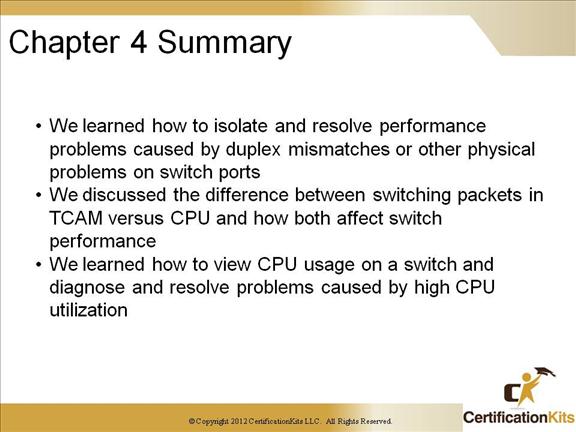Cisco CCNP TSHOOT Troubleshooting Switching Part III – HSRP vs. VRRP
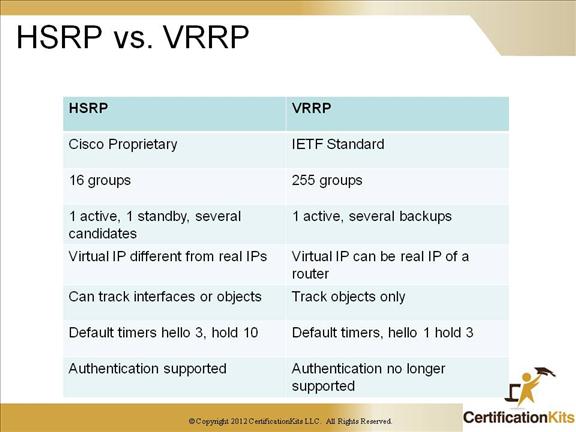
The above slide compares Cisco’s Proprietary HSRP with the standards based VRRP
Cisco CCNP TSHOOT VRRP
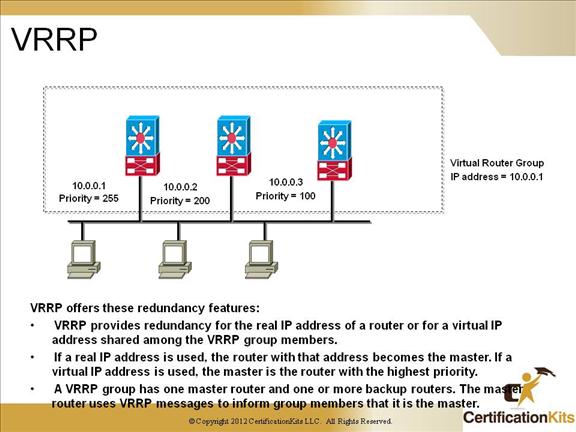
Like HSRP, VRRP allows a group of routers to form a single virtual router. In an HSRP or VRRP group, one router is elected to handle all requests sent to the virtual IP address. With HSRP, this is the active router. An HSRP group has one active router, at least one standby router, and perhaps many listening routers. A VRRP group has one master router and one or more backup routers.
The LAN workstations are then configured with the address of the virtual router as their default gateway. VRRP differs from HSRP in these ways:
– VRRP is an IEEE standard (RFC 2338) for router redundancy; HSRP is a Cisco Systems proprietary protocol.
– The virtual router, representing a group of routers, is known as a VRRP group.
– The active router is referred to as the master virtual router.
– The master virtual router may have the same IP address as the virtual router group.
– Multiple routers can function as backup routers.
– VRRP is supported on Ethernet, Fast Ethernet, and Gigabit Ethernet interfaces, and on Multiprotocol Label Switching (MPLS) virtual private networks (VPNs) and VLANs.
In the example, routers A, B, and C are members of a VRRP group. The IP address of the virtual router is the same as that of the LAN interface of router A (10.0.0.1). Router A is responsible for forwarding packets sent to this IP address.
Cisco CCNP TSHOOT Configuring VRRP
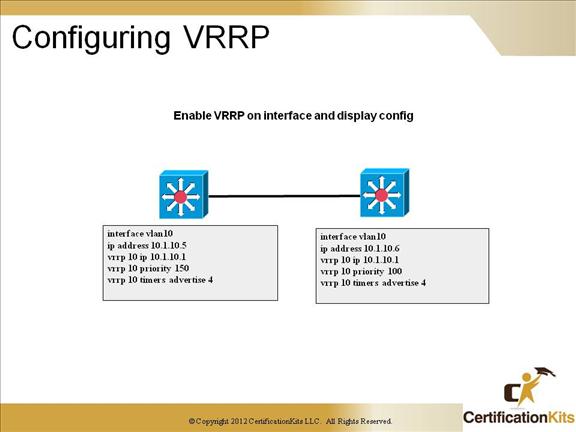
VRRP is configured in interface configuration mode utilizing the vrrp command with appropriate parameters.
Cisco CCNP TSHOOT VRRP Functionality and Example
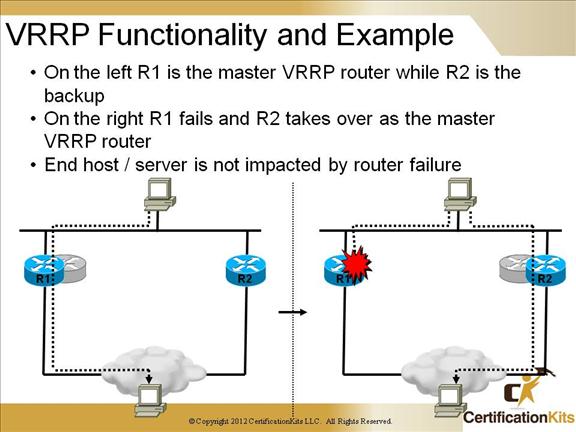
Again, similar to HSRP, the end hosts / servers point to a virtual IP Address that moves with the Master Router, hence the host is not impacted when a VRRP router fails.
Cisco CCNP TSHOOT Gateway Load Balancing Protocol
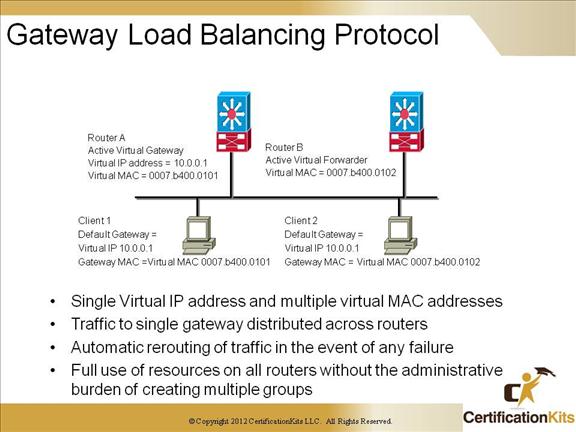
Although HSRP and VRRP provide gateway resiliency, for the standby members of the redundancy group, the upstream bandwidth is not used while the device is in standby mode.
Only the active router for HSRP and VRRP groups forwards traffic for the virtual MAC. Resources associated with the standby router are not fully utilized. Some load balancing can be accomplished with these protocols through the creation of multiple groups and through the assignment of multiple default gateways, but this configuration creates an administrative burden.
Cisco designed GLBP to allow automatic selection and simultaneous use of multiple available gateways in addition to automatic failover between those gateways. Multiple routers share the
load of frames that, from a client perspective, are sent to a single default gateway address.
With GLBP, resources can be fully utilized without the administrative burden of configuring multiple groups and managing multiple default gateway configurations, as is required with HSRP and VRRP.
Cisco CCNP TSHOOT Configuring GLBP
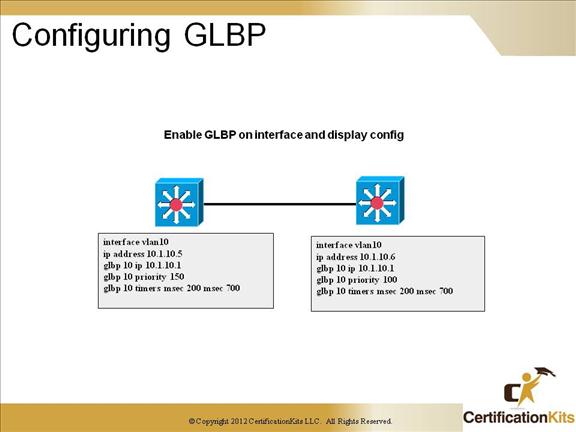
GLBP is configured in interface configuration mode utilizing the glbp command with appropriate parameters.
Cisco CCNP TSHOOT Troubleshooting Performance Problems
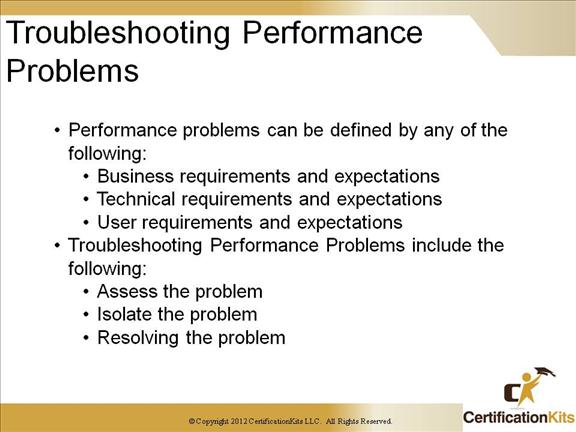
First determine if the problem is real or is there a perceived problem. If determined to be real (e.g. performance is not as expected), start troubleshooting. Try and isolate the problem to a particular link, device or component. After you have narrowed down the problem to a specific area, propose a solution and test it.
Cisco CCNP TSHOOT Layer 2 Switch Performance
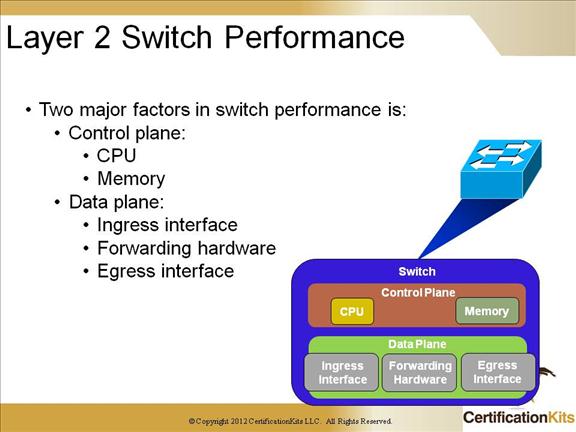
The control plane is separate from the data plane. The control plane is responsible for updating the information in the forwarding hardware. Also, the control plane handles any traffic that cannot be handled by the forwarding hardware. Hence, a high load on the control plane hardware could be an indication the forwarding hardware has either reached its capacity or is not handling traffic properly.
The data plane is responsible for switching traffic from ingress interface to egress interface.
Cisco CCNP TSHOOT Viewing Interface Statistics
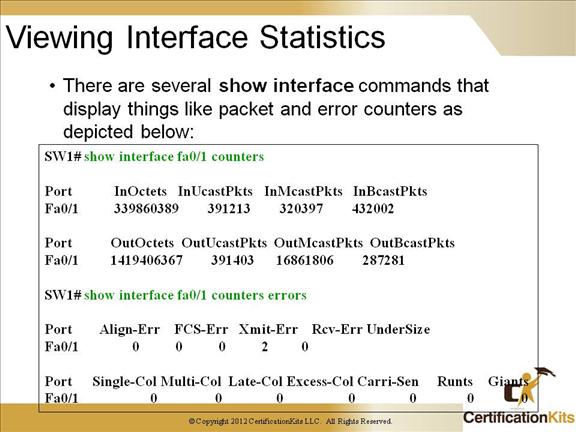
Errors on an interface is a good indication that there is probably a problem. Examples of different types of errors are:
Align-Err – Number of fames with alignment errors. Frames that do not end with an even number of octets and have a bad CRC.
FCS-Err – Number of valid size frames with FCS errors but no framing errors.
Xmit-Err – Indicates the internal transmit buffer is full.
Rcv-Err – Indicates the internal receive buffer is full.
Undersize – Number of frames received that are smaller that the smallest valid packet (64 bytes).
Single-Col – Number of times one collision occurs prior to a frame being successfully transmitted.
Multi-Col – Number of times multiple collisions occur prior to a frame being successfully transmitted.
Late-Col – Number of times a collision is detected late in the transmission process.
Excess-Col – Number of frames which fail due to excessive collisions.
Carri-Sen – On a half-duplex network, occurs every time a controller wants to transmit a frame.
Runts – Number of frames received that are smaller than 64 bytes that also have a bad CRC.
Giants – Number of non-jumbo frames received that exceed 1518 bytes and have a bad FCS.
Cisco CCNP TSHOOT Common Performance Problem
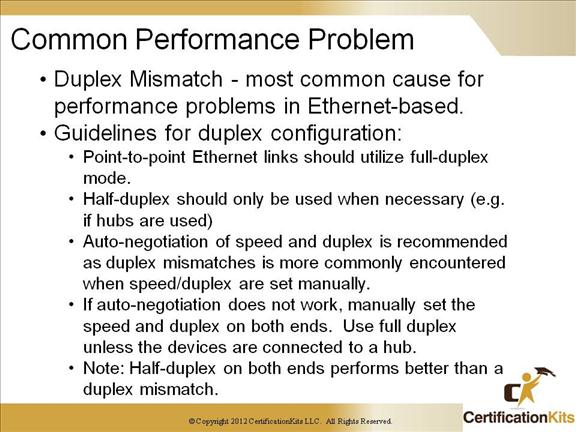
One of the most common performance problems are duplex mismatch. Auto-negotiation on both ends of the link is recommended. If that is not possible, force the duplex setting on both ends of the link. Problems occur when one end of the link is set for auto-negotiation while the other is set to full duplex. Since Fast Link Pulses (FLPs) are not seen on the auto-negotiation side, due to the other end being set to full duplex, the auto—negotiation side gets set to half-duplex causing a duplex mismatch.
Cisco CCNP TSHOOT Duplex Mismatch Problem
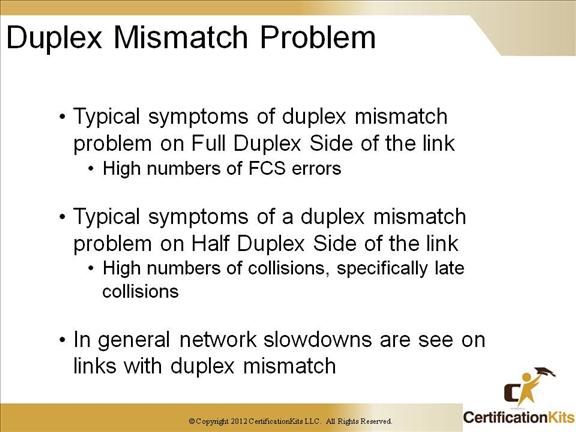
Network slowdowns typically occur on links that have a duplex mismatch (one side set to full duplex while the other side is set to half duplex).
Cisco CCNP TSHOOT Auto-MDIX / Speed / Duplex
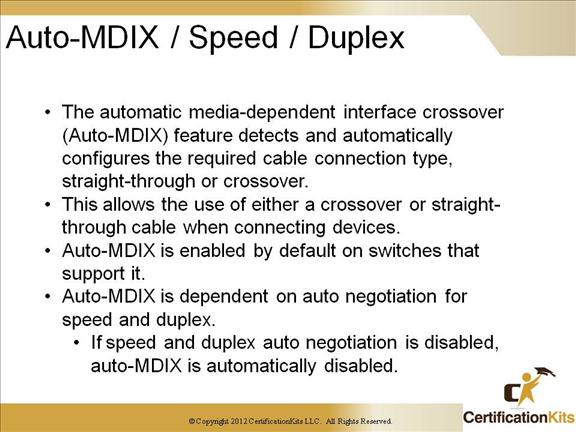
Auto-MDIX allows for use of either a straight-through or crossover cable regardless of what is connected at either end.
Cisco CCNP TSHOOT Configuration of Auto-MDIX
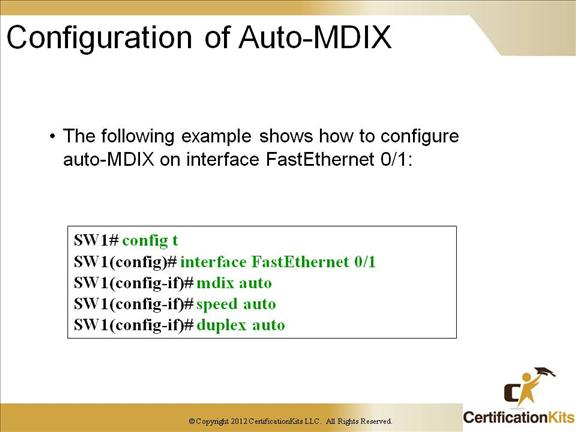
Starting with IOS version 12.2(20)SE, Auto-MDIX being enabled is the default setting so in those cases it is not necessary so specifically enable the feature.
Cisco CCNP TSHOOT Verification of Auto-MDIX
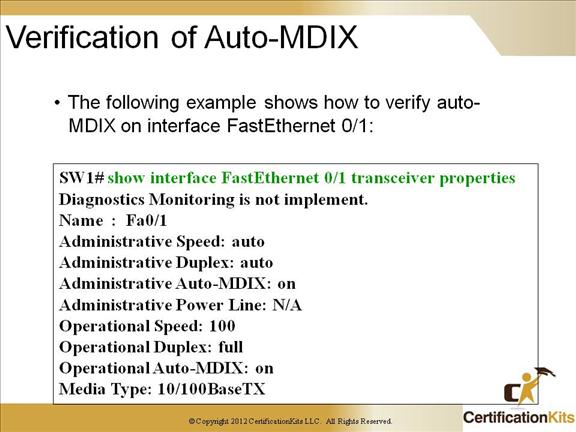
The show interface transceiver properties command can be used to verify the status of auto-MDIX, speed and duplex on an interface.
Cisco CCNP TSHOOT Ternary Content Addressable Memory (TCAM)
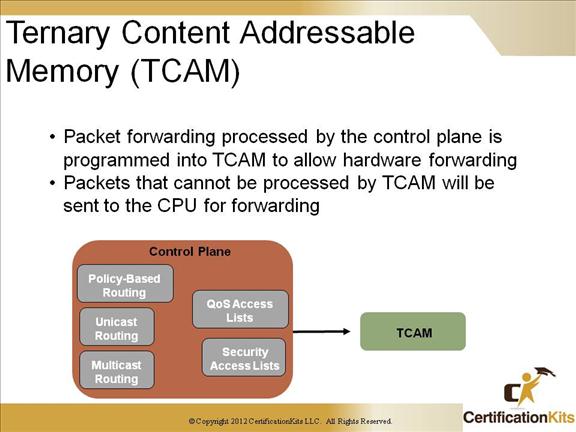
How a packet is processed can have a big impact on performance. The TCAM utilizes a specialized high performance memory lookup which speeds up performance. Control plane information that is necessary to make packet forwarding decisions (e.g. MAC address tables, routing information, etc) are programmed into the TCAM for fast lookup.
Cisco CCNP TSHOOT Verification of TCAM Utilization
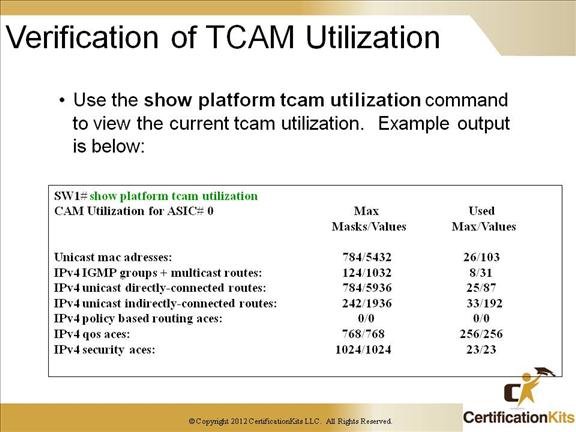
The show platform tcam utilization command can be used to see how much the tcam is being stressed.
Cisco CCNP TSHOOT Traffic Forwarding to the CPU
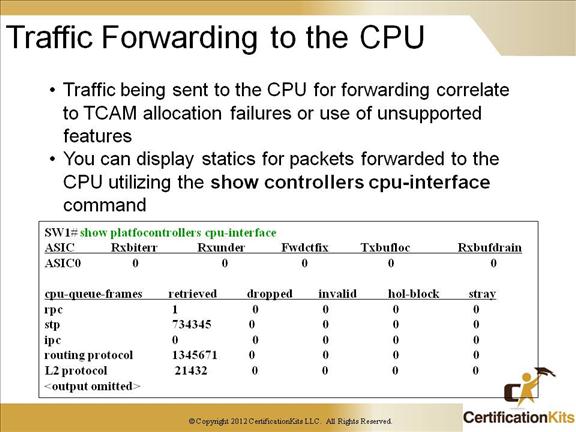
If subsequent outputs of the show controllers cpu-interface command has a rapidly increasing number for “sw forwarding” that is an indication that traffic is being forwarded to the CPU and is being switched in software in which case you will typically see high CPU utilization.
Cisco CCNP TSHOOT Viewing Switch CPU Load
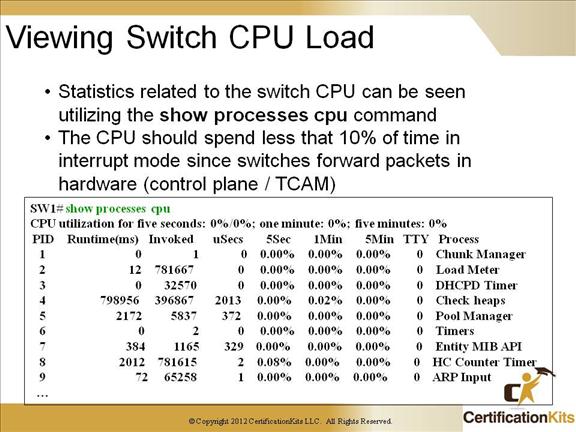
The show processes cpu command can be utilized to display CPU load.
Cisco CCNP TSHOOT Troubleshooting Switch CPU Load Problems
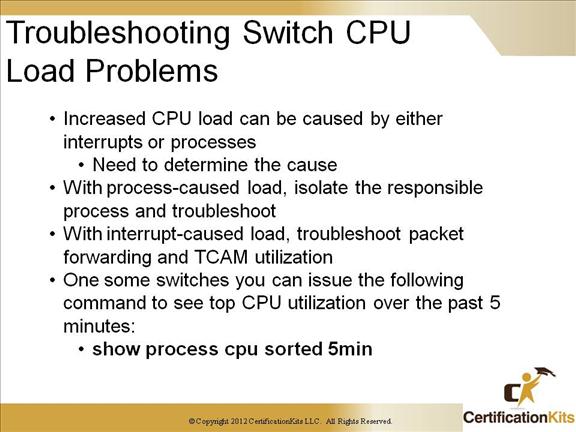
Remember that having debugging turned on will increase CPU utilization so only use when necessary and verify it is not enabled if you encounter a switch with high CPU utilization.
Cisco CCNP TSHOOT Chapter 4 Summary
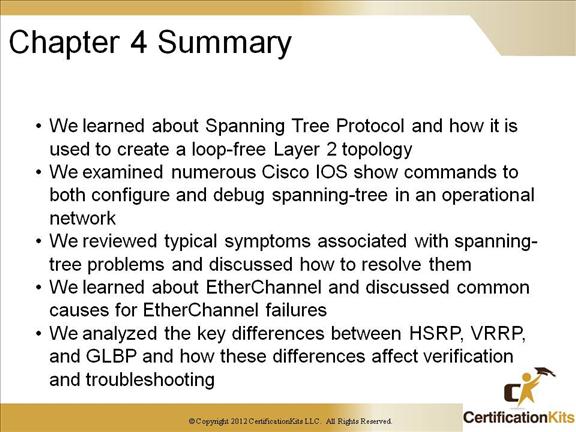
Cisco CCNP TSHOOT Chapter 4 Summary
